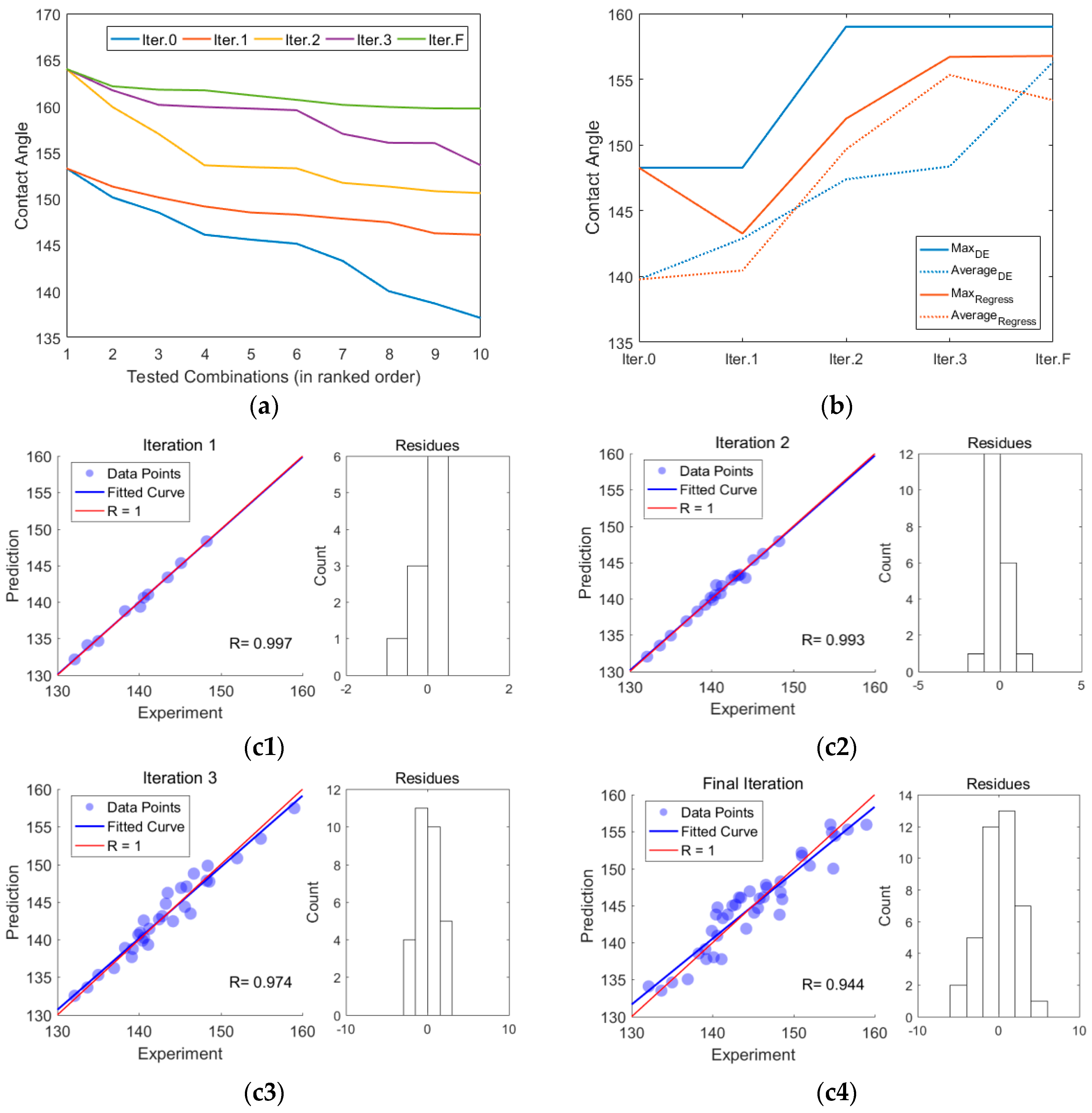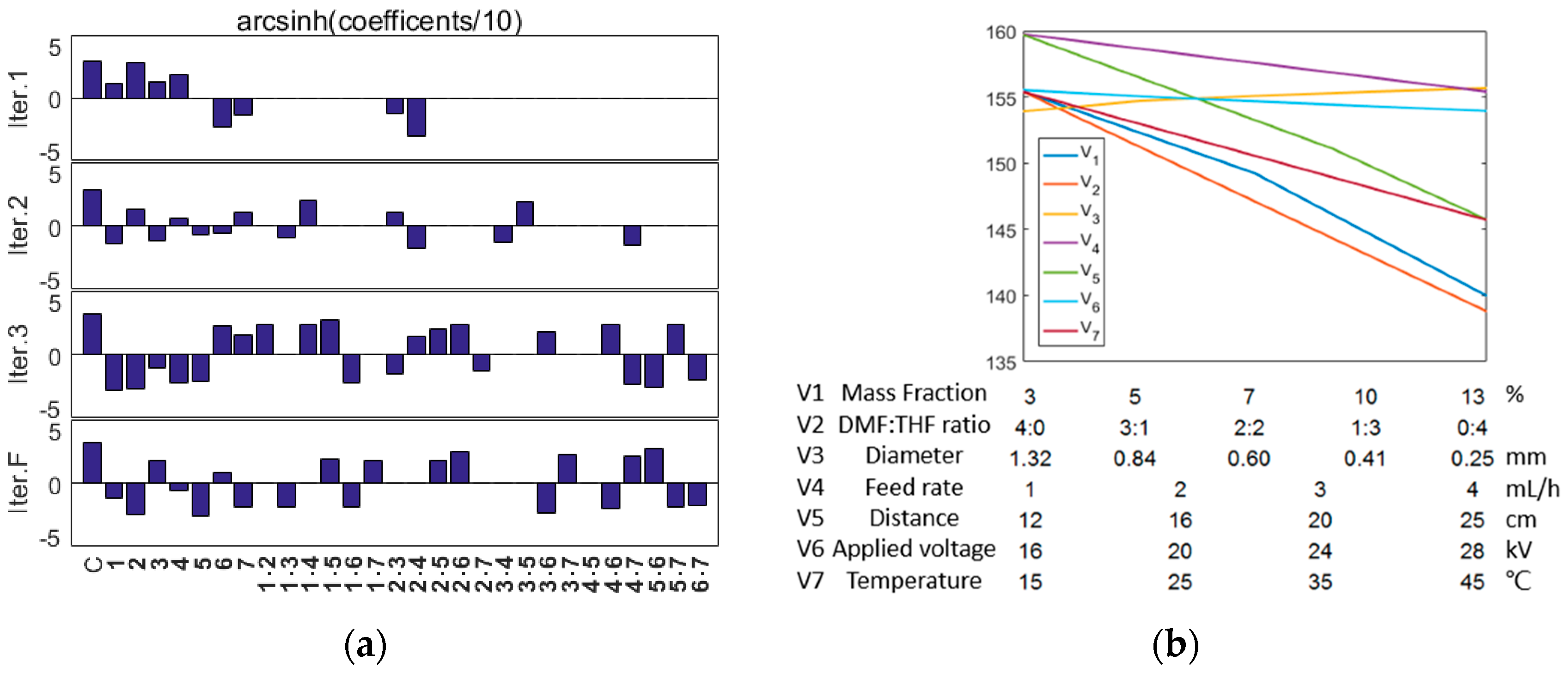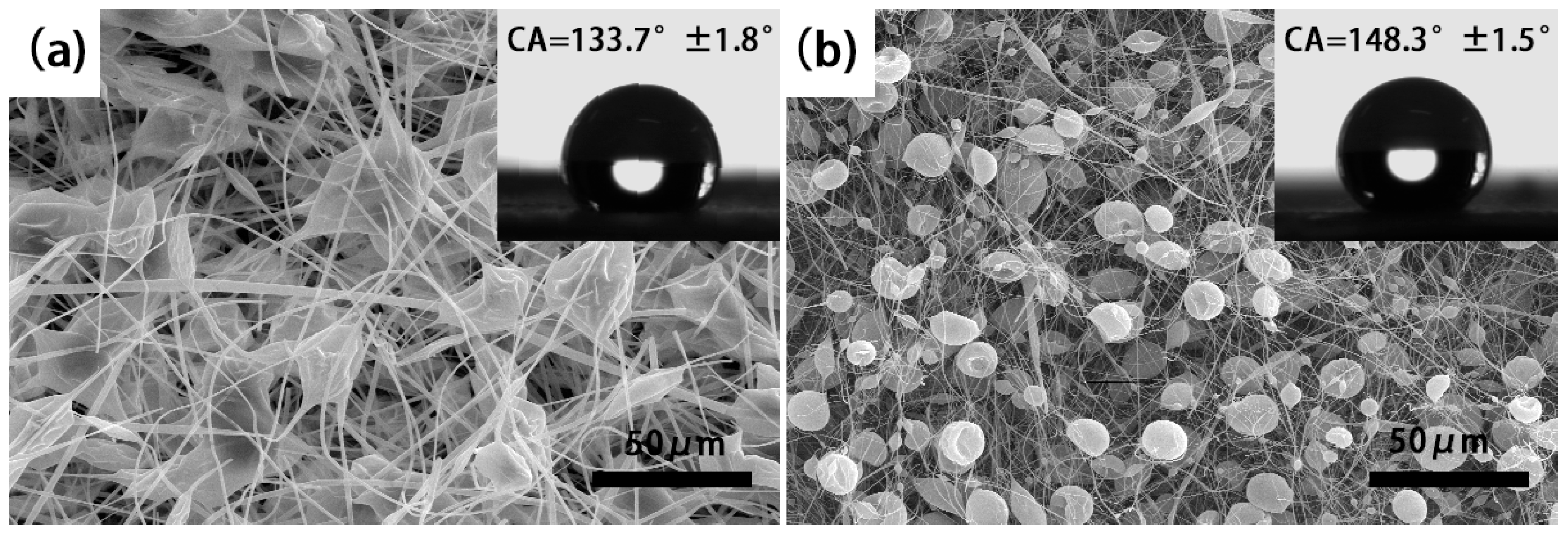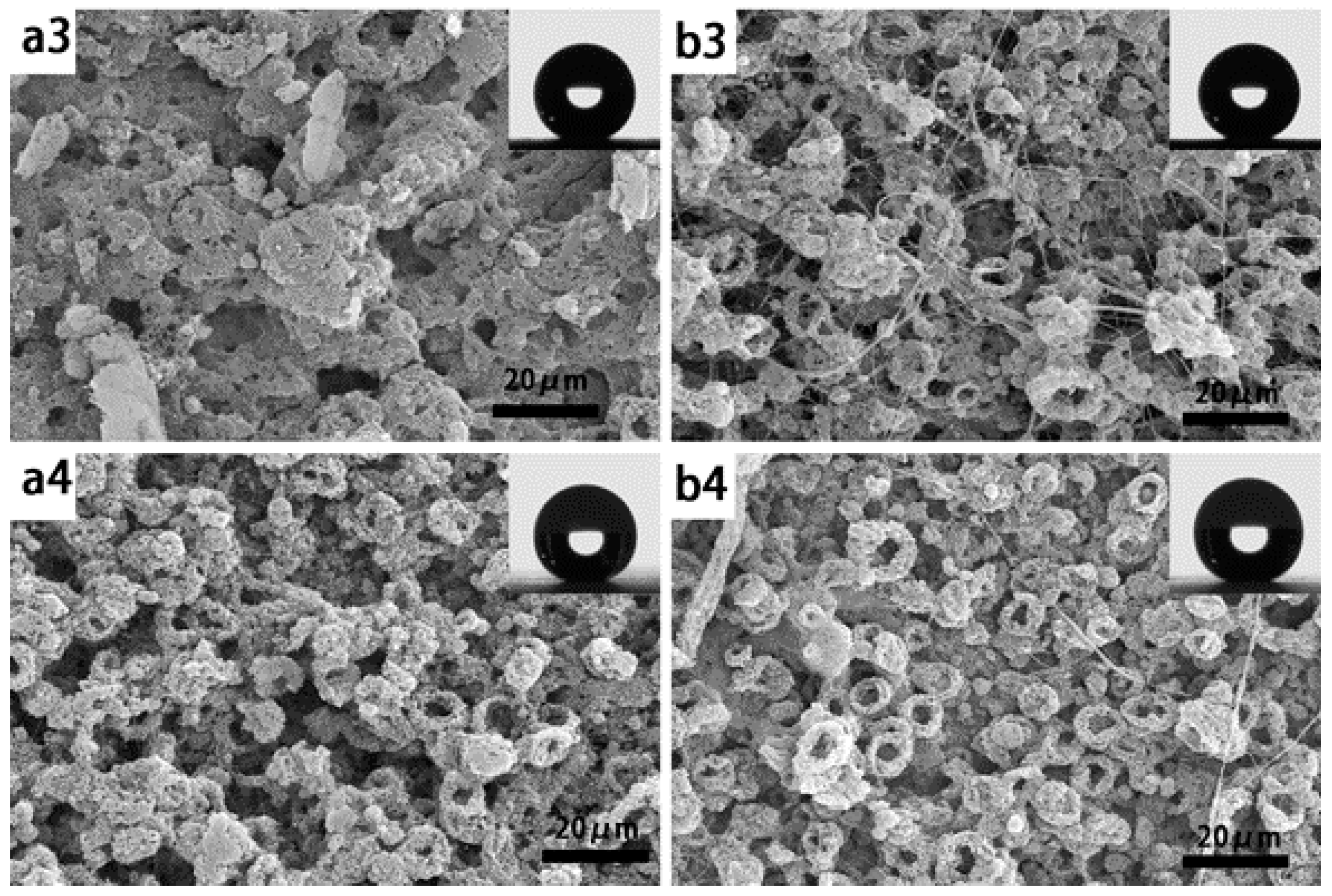1. Introduction
Superhydrophobic surface, which is defined as a surface with a static water contact angle (CA) greater than 150° and a water sliding angle (SA) smaller than 10° [
1], has attracted tremendous interests over the past few years. Some empirical models, such as the well-known Wenzel [
2] and Cassie-Baxter [
3] models, have been proposed to illustrate surface wetting properties and reveal the relationship between the surface roughness and water repellency. It is well recognized that the combination of suitable surface roughness and low-surface-energy materials is responsible for superhydrophobicity [
4]. The unique property is very important for many applications, such as filtration, oil/water separation, self-cleaning, anti-icing, and anti-corrosion [
4,
5], which in turn drives the relevant research on the fabrication of artificial superhydrophobic surface. Many techniques have been employed to fabricate superhydrophobic surface, such as plasma etching, sol-gel method, template synthesis, phase separation, crystallization control, chemical vapor deposition, and electrohydrodynamics (EHD) [
4,
5,
6].
As one of the most common EHD techniques, electrospinning is considered as the most efficient method to produce fibers with diameters in the range of nanometer, sub-micrometer, and micrometer. The bead-fibers or even particles that formed by electrospinning could potentially build a composite structure with possible superhydrophobic property. Fantini, et al. [
7] reported that microspheres or nanospheres could be produced by electrospinning, or called electrospray; as a result of surface tension, the liquid jet prefers to shrink to spherical droplets to acquire the smallest surface area. Jiang et al. [
8] has proved the superhydrophobic peculiarities of surfaces made up of a composite structure consisting of porous microspheres and nanofibers by electrospinning, they used polystyrene (PS) solution as precursor solution and successfully fabricated hierarchical microbead-fiber structure via electrospinning technology by changing the solution concentration individually. For its high roughness and low surface energy properties of the PS material itself, the fabricated membrane shows an excellent superhydrophobic property. The process of electrospinning is also easy to set up for laboratory research, as it offers many controllable parameters that can be used to obtain the required surface morphology, such as applied voltage, distance of collector, concentration of the solution, the choice of solvent, and pinhole size, etc., all of which have their respective influence on the fabricated film [
9]. As the surface morphology is the main factor for determining superhydrophobic property, just like the micro topology of lotus leaves, which have double scale roughness microstructure and low surface energy epicuticular wax [
10]. Therefore, superhydrophobic properties of the electrospun membrane can be generated by adjusting different processes and material parameters.
From the current research point of view, the researchers mostly studied the influence of single parameter by fixing other experimental parameters, and ignored the integrate influences to the structure of the fabricated electrospun membranes between the different parameters. In this study, we will change more than one parameter simultaneously to study the integrate influence of different parameters by algorithm, and meanwhile to search for an optimal parameter combination quickly to fabricate an excellent superhydrophobic surface by one-step electrospinning without any further modification. However, instead of testing all of the possible combinations of these parameters, we applied the feedback system control (FSC) platform to systematically search for optimal parameter combinations. The platform was based on the integration of experimental results and a feedback search guided by the differential evolution (DE) algorithm and stepwise regression. With the FSC platform, only a few possible combinations are needed to derive effective combination from a vast search space. The FSC technique [
11,
12,
13,
14] focuses on a desired phenotypic output, such as the superhydrophobic property of the fabricated membrane by electrospinning, as in this study, rather than on detailed mechanism hypothesis on factor-factor interactions.
3. Results and Discussion
Making a rough substrate and meanwhile modifying it with low energy materials is the main method to make superhydrophobic surface. EHD technique has proved to be an effective yet simple method for fabricating microsphere/nanofiber composite film with a very rough surface by one-step without any modification. Here, by adjusting the seven parameters that mainly impact the morphology of membrane, we search for an optimal condition quickly via the FSC platform that could fabricate electrospun membrane with enough roughness to achieve a best performance about superhydrophobic property. In this study, since the contact angle of the electrospun membrane was the sole objective function used in the FSC screening for different parameter combinations, 10 initial parallel combinations with arbitrarily chosen values were generated using the numerical analysis software MATLAB. As the FSC progressed, the 10 parameter combinations were updated based on the measured CA values of the electrospun membranes.
The first round of combinatorial experiments is marked as Iteration 0, since the initial combinations were not generated by our optimization approaches. The optimization process started at the second round, marked as Iteration 1 and stopped at the fourth round marked as Iteration 3 where several good-performance combinations have already been found. In addition, we also performed the fifth round of experiments including only six combinations for testing our optimization and modeling methods, which was marked as Final Iteration (Iter.F). In each iteration, seven of the ten combinations were generated by the DE algorithm with data of nine best rank combinations in the previous round of experiments and the other three combinations were generated from the regression model using all the available combinatorial data. The Mutation Rate (M) and Crossover Rate (P) in the DE algorithm were separately 0.75 and 0.75 for higher evolution rate so that optimal combinations could be found in limited iterations (
Figure A2). Stepwise regression was chosen as the modeling approach for its flexibility and self-adaptability on dealing with both small and large data volumes (
Figure A3). To avoid overfitting, we adjusted the thresholds of the term adding and removing criterion in stepwise regression where the number of terms in the model was less than the number of data points. The model for predicting each iteration of experiments are all well regressed with the correlation coefficient, R, greater than 0.9 and well distributed residues (
Figure 1c).
As shown in
Figure 2a, with the integration of DE and stepwise regression, the contact angle was optimized iteratively. The optimal combination was found in the third round of experiments, but in the subsequent iterations more combinations with acceptable contact angles were discovered for further characterization afterwards. From the first round of iteration represented by blue line, to the final round of iteration represented by green line, the contact angle as the objective function value had a growing trend; furthermore, the line of each round became smoother as the FSC progressed and reached a relative plateau at the final round, of which the CA values are all larger than 155°.
Figure 2b demonstrated the contribution of the DE algorithm and regression in the whole optimization process. At first, with limited number of data points (Iter.1), the regression model had a poor performance resulting in the fact that the best prediction was inferior to the best of the initial design (Iter.0). However, although the optimum was identified by DE in Iter.2 by chance, the performance of regression modeling improved steadily in Iter.2 & 3 with more data points involved. Predictions of regression modeling provided a guideline for the stochastic search of the DE algorithm, therefore making the average contact angle of DE-generated combinations greater than regression modeling again in the end (Iter.F).
This integrative platform of DE and stepwise regression seems to be more efficient than conventional FSC platforms 14 in identification of optimal combinations. Moreover, the regression model can tell us the contribution of each parameter and their interactions to the CA value (
Figure 2) by evaluating the coefficients. With more data points acquired, the regression model has gone through an evolution process (
Figure 2a), wherein the contributions of some terms disappeared and some emerged in each iteration, making the model much more robust. To directly demonstrate the contribution of the parameters, we adopted the model of the Final iteration to predict how each single parameter and their interactions would affect the CA value at the optimum state. It can be seen from the bottom term of
Figure 3a that the interactions between these seven parameters have different intensity effect on the CA values.
Figure 3b shows that lower mass fraction, THF ratio, feed rate, receiving distance, and temperature may benefit the CA value while the nozzle diameter and applied voltage have little effect.
For the purpose of verifying the optimization process from the perspective of microstructure, the change process of the morphologies of electrospun membranes can be observed. In the initial round, the CA values of all fabricated electrospun membranes are smaller than 150°, while some are even smaller than 140°. SEM images indicated that all of them are hierarchical microbead-fiber structure, which can maintain air entrapped in the bulk layers. By providing continuous water-air-solid interfaces, it can keep a stable state of superhydrophobicity. The differences between them are the shape and size of beads and the diameter of fibers.
Figure 4 shows the morphologies of the best and worst hydrophobic membranes in the initial round. Obviously, the bead and the diameter of fibers of
Figure 3a are larger than
Figure 4b, and the bead of
Figure 4a shows an irregular shape while of
Figure 3b has a very uneven size distribution that range from 2 μm to 12 μm. However, the smaller structure has a better hydrophobic performance.
Then, after operating several rounds of experiments that were predicted by DE and regression, the structure of the membranes became much smaller and rougher to get a much better performance on hydrophobicity. As shown in
Figure 5, (a1) and (b1) show the morphologies of electrospun membranes, which have the best hydrophobic performance (CA = 146.3° and 143.3°) of the first round predicted by DE and regression separately. It can be seen that they are both composite membrane with a hierarchical microbead-fiber structure. (a2) and (b2) are the best (CA = 159.0° and 152.0°) in the second prediction round. When compared to (a1) and (b1), (a2) and (b2) both scarcely have fibers. As the same as (a3), (b3) (CA = 155.1° and 156.7°) and (a4), (b4) (CA = 156.8° and 157.1°), the particles or irregular shape clusters are the main structure of the electrospun membranes. Especially, the irregular shape cluster has a very rough surface that has a much smaller magnitude. It can be observed that from
Figure 6, a rough surface with a nanoscale structure was formed, combined with the microscale gaps between clusters, resulting in creating enhanced surface roughness and additional surface area, which significantly improves the superhydrophobic property. With the CA value much larger than 150°, the water sliding angle (SA) is very small, about 2.1°, that is much smaller than 10°.
4. Conclusions
In this study, an optimal parameter combination was quickly and successfully identified via the FSC platform with the integration of DE and stepwise regression to fabricate an excellent superhydrophobic surface with CA values reaching up to 159.0° and SA smaller than 3° by one-step electrospinning without any further modification. Five rounds of experiments were conducted. The first four rounds of experiments included 10 combinations, while the final round of experiments included only six combinations, which was used to test our optimization and modeling methods. In each iteration except the first one, seven of the ten combinations were generated by the DE algorithm with data of the best rank combinations in the previous round of experiments, and the other three combinations were generated from the regression model using all of the available combinatorial data. After four rounds of iterations, it can be found that several good-performance combinations with CA values of the fabricated electrospun membranes are larger than 155°. With the final iteration, the regression model also determined the contribution of each parameter and their interactions to the CA value that lower mass fraction, THF ratio, feed rate, receiving distance, and temperature may benefit the CA value while the pinhole size and applied voltage have little effect. In conclusion, this work provides an efficient method to investigate the integrated influence of different parameters on the property of electrospun membrane and quickly search for an optimal parameter combination to fabricate excellent superhydrophobic surface by electrospinning, by which only a few rounds of experiments are needed from a vast search space with multiple search parameters.















